How to Repurpose Content for Maximum Impact
Sep 06, 2024
Written by Casey Bjorkdahl

Casey Bjorkdahl is one of the pioneering thought leaders in the SEO community. In 2010, Casey co-founded Vazoola after working for a Digital Marketing Agency for five years in New York City. Vazoola is now one of the fastest growing and most widely recognized SEO marketing firms in the country.

Do you know what to do with old blog posts?
Creating fresh content constantly can be an exhausting and time-consuming task. Surely there must be a more efficient way to publish linkable assets. How can content marketers get the most bang for their buck?
Repurposing content offers a smart solution to this common predicament. According to a ReferralRock survey, 94% of content marketers repurpose their content for different channels or mediums. 46% of them say it provides the best results.

This repurposing content strategy doesn’t only save time. It also maximizes the reach and impact of your existing content. It’s simply good financial sense to make the most of content you’ve already spent time and money producing.
Key Takeaways
-
Content repurposing is essential for maximizing efficiency and reach.
-
Three actionable strategies can help you repurpose your content effectively.
-
Repurposed content offers insights on boosting SEO and expanding audience reach.
Table of Contents:
-
3 Effective Ways to Repurpose Your Content
-
Method 1: Turn Blog Posts into Other Formats
-
Method 2: Repurpose Videos and Podcasts
-
Method 3: Refresh and Update Older Content
-
Benefits of Repurposing Content

So, what’s the deal with repurposed content? What is content repurposing?
Repurposing old content benefits SEO campaigns in multiple ways.
From saving resources to expanding reach, repurposing should be in the SEO arsenal of anyone hoping to enhance their search engine optimization.
Save Time and Resources
Repurposing existing content is far more efficient than creating new content from scratch. Instead of starting with a blank slate, you can transform your well-researched and high-quality content into a variety of formats.
Did you already create a blog post with statistics? Convert them into an infographic. Did you publish an interview? Pull the quotes for social media content. The ways to repurpose content are too many to name.
The repurposing approach allows you to leverage your initial content efforts across multiple platforms.
For example, a comprehensive blog post might be broken down into several smaller pieces of content – think social media posts, infographics, and videos – each serving a different purpose and reaching a new audience.
Expand Your Reach
Different content formats appeal to different audiences and platforms. When you convert a blog post into a video, infographic, or social media snippet, you ultimately engage with a broader audience.
The multi-format strategy increases your message's visibility and ensures it reaches diverse groups.
For example, while some users prefer reading long-form articles, others might find infographics more engaging or videos more accessible. The variety of repurposed content helps capture the attention of a wider audience.
Boost SEO
Are you ready to boost your SEO? What if you can do it without investing more time and money? Repurposed content is an effective way to improve your website's search engine ranking.
When you refresh and update your content, search engines notice the activity. That recognition in turn lead to better indexing. Likewise, sharing the same content in different formats on multiple platforms creates multiple backlinks, further enhancing your SEO efforts.
For example, an updated blog post shared on LinkedIn can attract backlinks from professionals in your industry, boosting your site's authority.
Pro Tips:
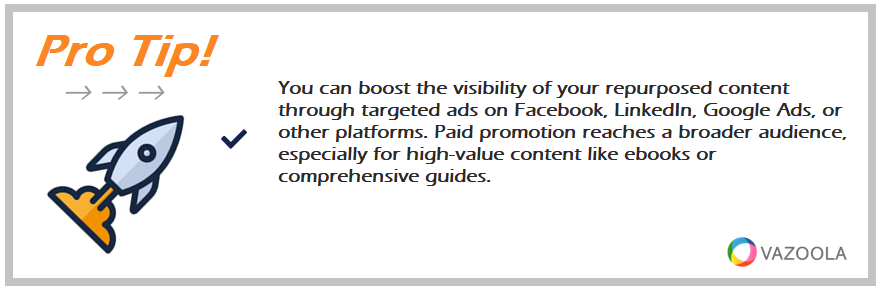
You can boost the visibility of your repurposed content through targeted ads on Facebook, LinkedIn, Google Ads, or other platforms. Paid promotion reaches a broader audience, especially for high-value content like eBooks or comprehensive guides.
3 Effective Best Practices for Repurposing Content
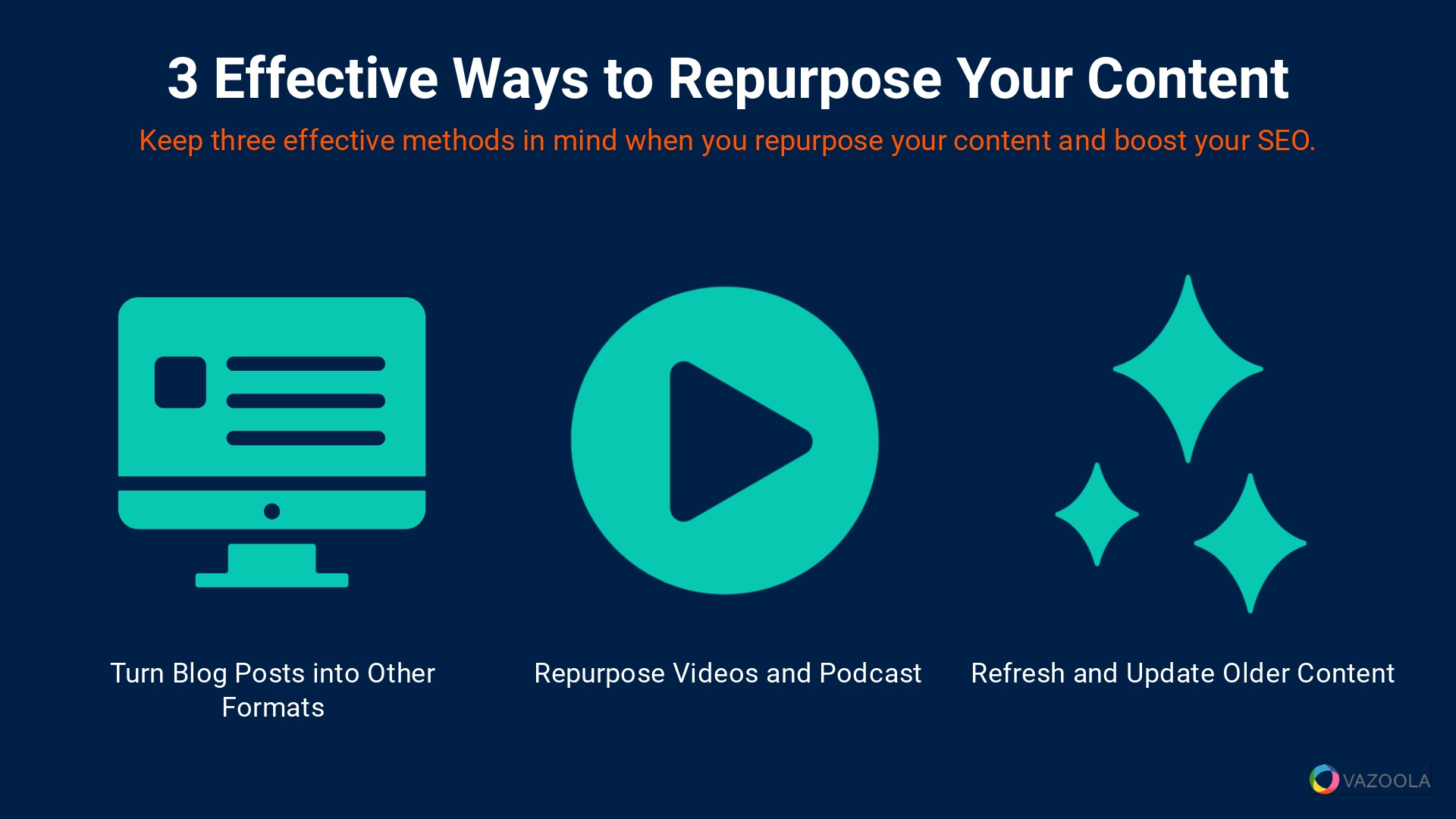
So, now you know how important it is to repurpose old content. But where do you begin?
Keep the following effective methods in mind when you repurpose your content and boost your SEO.
Method 1: Turn Blog Posts into Other Formats
To what other formats can you convert your old content? Should you choose videos, social media posts, or maybe just refresh an old blog post? A variety of options are available to help repurpose your content.
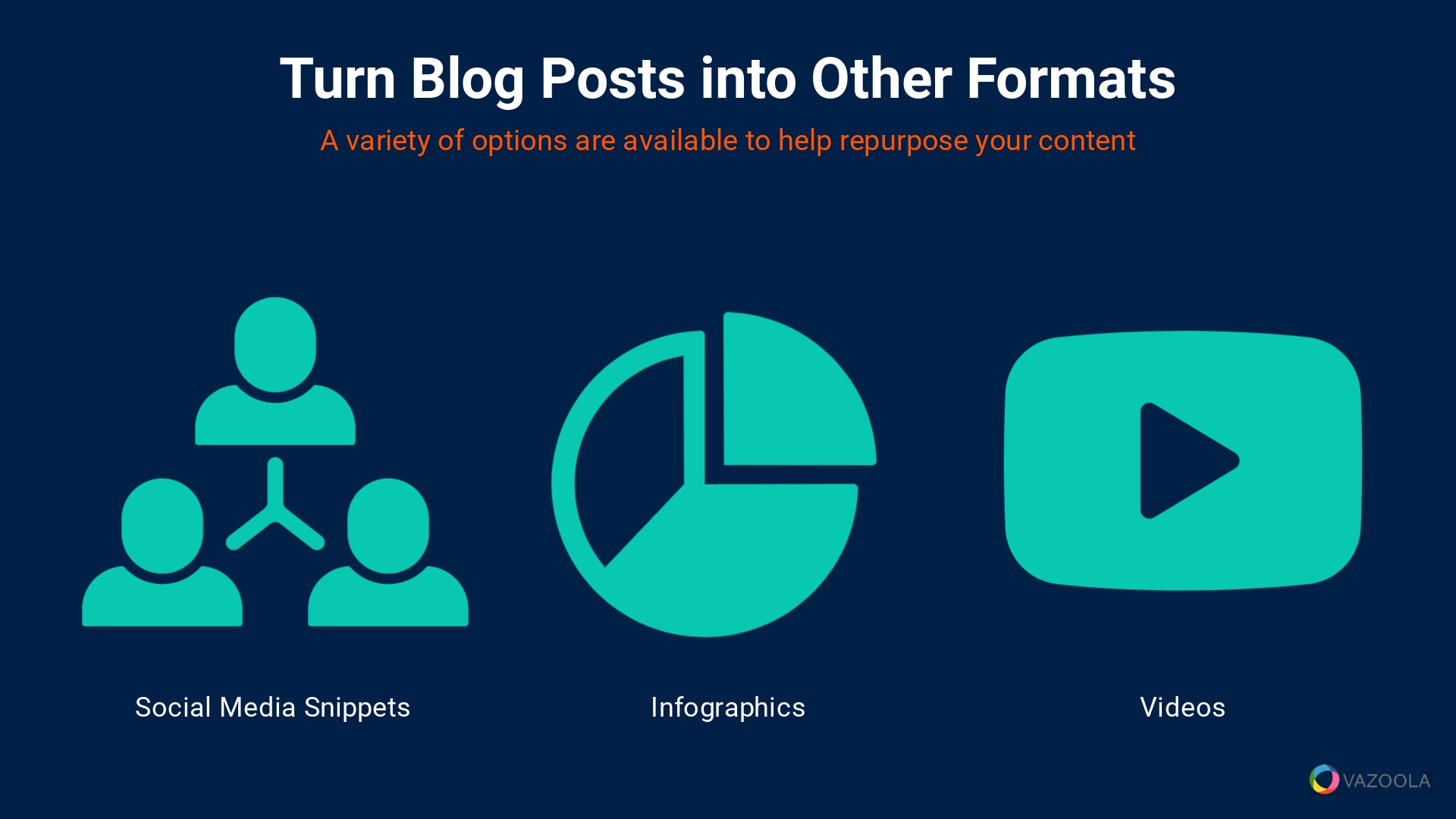
Social Media Snippets
Do you know how to repurpose content for social media? Extract key quotes or statistics from your blog posts and share them on social media platforms like X (formerly known as Twitter), LinkedIn, or Instagram.
These sorts of snippets can drive traffic back to your original post and engage your followers with valuable information.
For example, if your blog post includes a compelling statistic, you can repurpose content for social media if you create a visually appealing graphic featuring that statistic and share it with a link to the full post.
Infographics
Transform complex blog post data into visually appealing infographics that are easy to share and understand. Infographics can simplify your message and make it more accessible to a visual audience.
For example, if your blog post contains numerous statistics or steps, summarizing them in an infographic can increase their impact.
Use tools like Canva or Piktochart to create professional-looking infographics without needing a graphic design background.
Videos
Create short videos summarizing the main points of your blog post and share them on YouTube, Facebook, or TikTok.
Videos are highly engaging and can convey your message effectively. You can use tools like Lumen5 or Animoto to convert your blog content into captivating videos.
For instance, if your blog post is about tips for improving SEO, create a short video highlighting the top three tips and link back to the full post for more details.
Pro Tips:
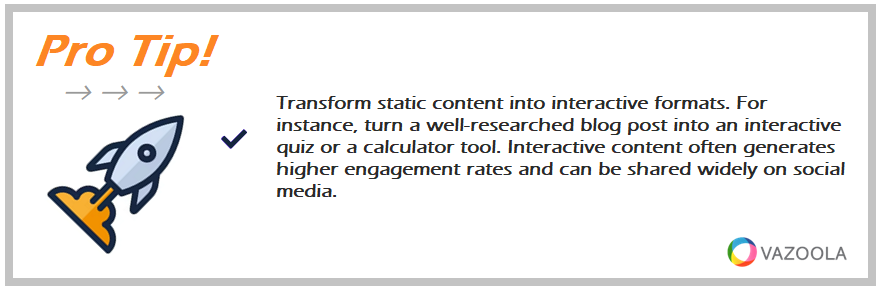
Transform static content into interactive formats. For instance, turn a well-researched blog post into an interactive quiz or a calculator tool. Interactive content often generates higher engagement rates and can be shared widely on social media.
Method 2: Repurpose Videos and Podcasts
You can probably think of ways to convert old content into videos, but how do you repurpose videos into something else? A variety of mediums are available for video repurposing, ranging from transcripts to quotation graphics.

Transcripts
Create written transcripts of your videos or podcasts and publish them on your website or blog.
Transcripts make your content accessible to a wider audience, including those who prefer reading over watching or listening. They also enhance SEO by providing additional text for search engines to index.
For instance, a podcast episode on digital marketing strategies can be transcribed and published as a blog post, attracting search engine traffic for relevant keywords.
Short Clips
Extract highlights from your videos or podcasts and share them as standalone clips on social media.
Short clips can serve as teasers, enticing your audience to watch the full video or listen to the complete podcast episode.
For example, if your podcast features an interview with an industry expert, share a compelling quote or insight from the interview as a short clip to attract interest.
Quote Graphics
Create eye-catching graphics featuring memorable quotes from your videos or podcasts. Share the graphics on platforms like Instagram and Pinterest to engage your audience and drive interest in your content.
Tools like Canva can help you design visually appealing quote graphics easily.
For instance, a powerful quote from a podcast guest can be turned into a graphic that resonates with your audience and encourages them to listen to the full episode.
Pro Tips:
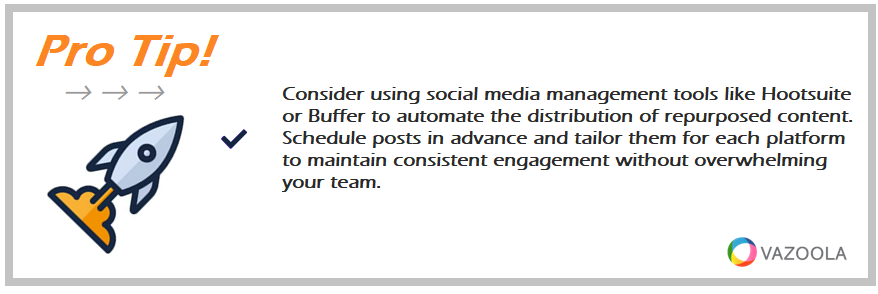
Consider using social media management tools like Hootsuite or Buffer to automate the distribution of repurposed content. Schedule posts in advance and tailor them for each platform to maintain consistent engagement without overwhelming your team.
Method 3: Refresh and Update Older Content
You don’t have to convert your older content into an entirely new medium to repurpose it. You can give it a makeover by updating data, adding new imagery or even some relevant videos.
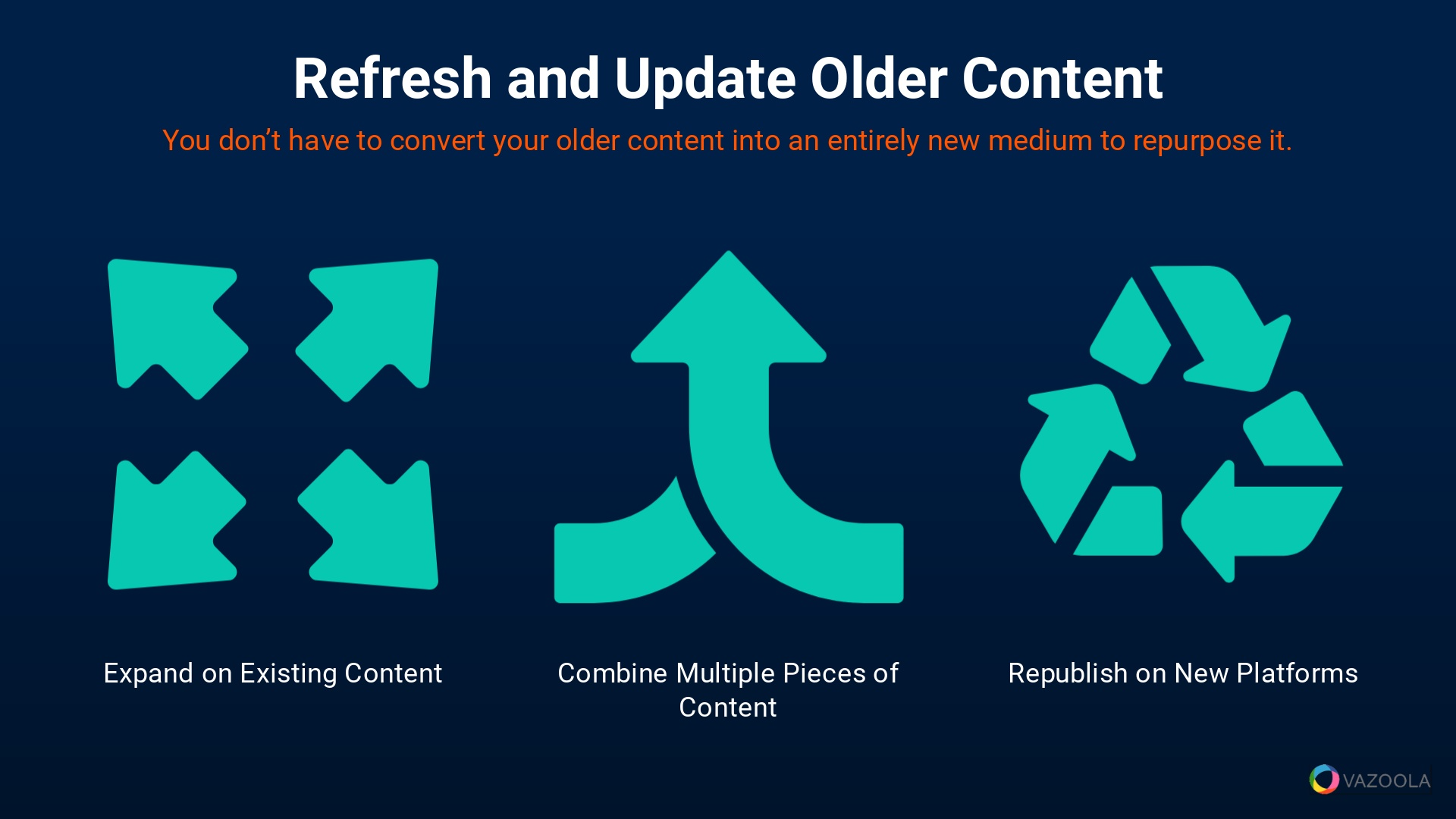
Expand on Existing Topics
Add new information, data, or examples to your existing blog posts, articles, or videos to keep them relevant and up-to-date.
This type of refresh can improve your content's accuracy and appeal, attracting both new and returning readers.
For instance, if you have a blog post on social media trends from last year, update it with the latest trends and statistics for the current year.
Combine Multiple Pieces of Content
Merge related blog posts, articles, or videos into a comprehensive guide or ebook. This approach can provide your audience with a valuable resource while extending the lifespan of your existing content.
For a repurpose example, if you have several blog posts on content marketing, combining them into an ebook can create a powerful tool for your readers.
Promote the ebook through your email list and social media channels to maximize its reach.
Republish on New Platforms
Share your existing content on new platforms or channels to reach a wider audience.
For instance, if you initially published a blog post on your website, consider sharing it on Medium, LinkedIn Pulse, or industry-specific forums.
The strategy can introduce your content to new readers and generate additional traffic. Additionally, consider translating your content into other languages to reach international audiences.
Pro Tips:
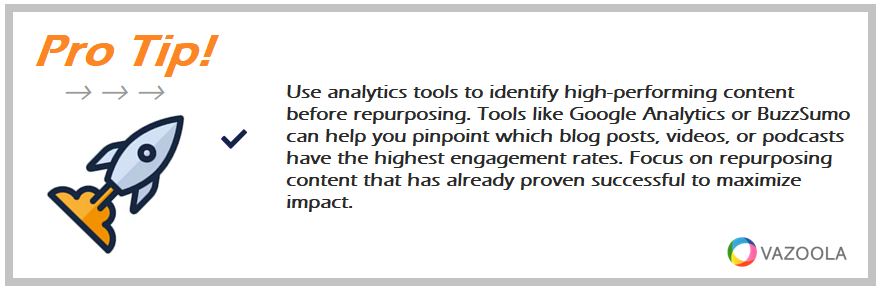
Use analytics tools to identify high-performing content before repurposing. Tools like Google Analytics or BuzzSumo can help you pinpoint which blog posts, videos, or podcasts have the highest engagement rates. Focus on repurposing content that has already proven successful to maximize impact.
Maximize SEO with Repurposed Content
Now that you know what is repurposing content, you can understand it’s a powerful strategy for maximizing the impact and reach of your existing work.
By saving time and resources, expanding your reach, and boosting SEO, you can make sure your content remains effective and relevant.
Start experimenting with the above three methods to see how repurposing can transform your content strategy.
We'd love to discuss how repurposing content and other SEO strategies can help your digital marketing campaigns. Request a free demo today!
Pro Tips:
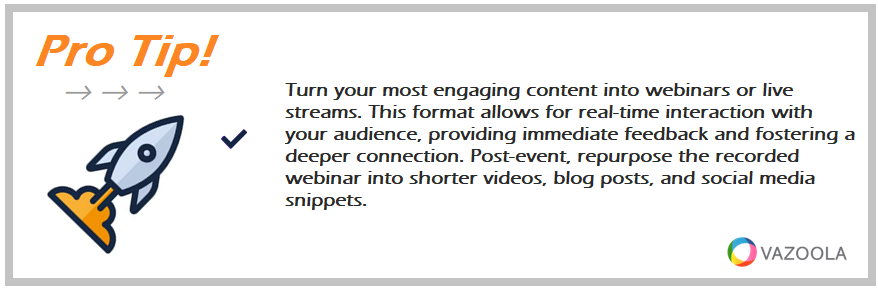
Turn your most engaging content into webinars or live streams. This format allows for real-time interaction with your audience, providing immediate feedback and fostering a deeper connection. Post-event, repurpose the recorded webinar into shorter videos, blog posts, and social media snippets.

